
Get matched with top structural engineers in Madbury, NH
Enter your zip and get matched with up to 5 pros
Need a pro for your structural engineering project in Madbury, NH?
Find Structural engineers in Madbury
GROOVER SEPTIC DESIGN
GROOVER SEPTIC DESIGN
Home business, no other employes, payment on job completion, cash or personal check.
Home business, no other employes, payment on job completion, cash or personal check.

EHM
EHM
EHM is a structural moving and elevating company that also specializes in foundation repair and replacement. We have been working in the Midwest since the Great Floods of 1993. We specialize in severely comprised foundation issues. We can elevate, level, pier or replace a wall or your entire foundation. We do not do mudjacking, waterproofing or minor crack repair.
"I did not get the service that we originally talked about I am very unhappy"
Donna S on August 2021
EHM is a structural moving and elevating company that also specializes in foundation repair and replacement. We have been working in the Midwest since the Great Floods of 1993. We specialize in severely comprised foundation issues. We can elevate, level, pier or replace a wall or your entire foundation. We do not do mudjacking, waterproofing or minor crack repair.
"I did not get the service that we originally talked about I am very unhappy"
Donna S on August 2021
CIVIL DESIGN ENGINEERING CONSULTANTS LLC
CIVIL DESIGN ENGINEERING CONSULTANTS LLC
ADDITIONAL ADDRESS PO BOX 312.
ADDITIONAL ADDRESS PO BOX 312.
Riverview Home Design Group
Riverview Home Design Group
We are a growing architecture firm located on the south shore of Massachusetts. We specialize in residential additions, renovation, structural design and new construction.
We are a growing architecture firm located on the south shore of Massachusetts. We specialize in residential additions, renovation, structural design and new construction.
Michael Weatherby & Associates
Michael Weatherby & Associates
Full service commercial residential contracting firm, insured, certified EPA firm, HERS certification, VT EMP lead safe practices, over 40 years experience
Full service commercial residential contracting firm, insured, certified EPA firm, HERS certification, VT EMP lead safe practices, over 40 years experience
The Madbury, NH homeowners’ guide to structural engineering services
From average costs to expert advice, get all the answers you need to get your job done.

The cost of a structural engineer is easily justifiable given the value they bring to the table. Use this guide to see what hiring your professional will total in Philadelphia, PA.

The cost of a structural engineer is easily justifiable given the value they bring to the table. Use this guide to see what hiring your professional will total in Seattle, WA.

The cost of a structural engineer is easily justifiable given the value they bring to the table. Use this guide to see what hiring your professional will total in Tampa, FL.

Removing columns can open up a space, but you’ll need to exercise caution to avoid damaging your home’s structure. Use these steps to find out if your column is load-bearing.

Before removing a wall, make sure it’s not load-bearing. Learn the benefits of hiring a structural engineer to check if a wall is load-bearing.

Keeping your home safe and structurally sound should be a top priority. Learn to recognize the signs of structural damage you should never ignore.
- Dover, NH Structural engineers
- Rollinsford, NH Structural engineers
- Somersworth, NH Structural engineers
- Durham, NH Structural engineers
- Barrington, NH Structural engineers
- Newmarket, NH Structural engineers
- Rochester, NH Structural engineers
- Lee, NH Structural engineers
- Portsmouth, NH Structural engineers
- Newington, NH Structural engineers
- Newfields, NH Structural engineers
- Greenland, NH Structural engineers
- North Berwick, ME Structural engineers
- Stratham, NH Structural engineers
- New Castle, NH Structural engineers
- Nottingham, NH Structural engineers
- Epping, NH Structural engineers
- Rye, NH Structural engineers
- Northwood, NH Structural engineers
- North Hampton, NH Structural engineers
- Ogunquit, ME Structural engineers
- Kensington, NH Structural engineers
- Brentwood, NH Structural engineers
- Plumbing in Madbury
- Kitchen And Bath Remodeling in Madbury
- Flooring in Madbury
- Roofing in Madbury
- Stone And Gravel in Madbury
- Property Appraiser in Madbury
- Siding in Madbury
- Gutter Cleaning in Madbury
- Deck Maintenance in Madbury
- Electrical in Madbury
- Exterior Painting in Madbury
- Pressure Washing in Madbury
- Septic Tank in Madbury
- Painting in Madbury
- Cabinet Refinishing in Madbury
- Windows in Madbury
- Water And Smoke Damage in Madbury
- Driveways in Madbury
- Interior Painting in Madbury
- Cleaning in Madbury
- Small Appliance Repair in Madbury
- Sunroom And Patio Remodeling in Madbury
- Roofing in Madbury
- Plumbing in Madbury
- Tree Service in Madbury
- Electrical in Madbury
- Kitchen And Bath Remodeling in Madbury
- Siding in Madbury
- Landscaping in Madbury
- Cleaning in Madbury
- 🌱 "Mow a small front yard"
- 🛠 "Fix a leaking pipe under the sink"
- 🏠 "Repair shingles on an asphalt roof"